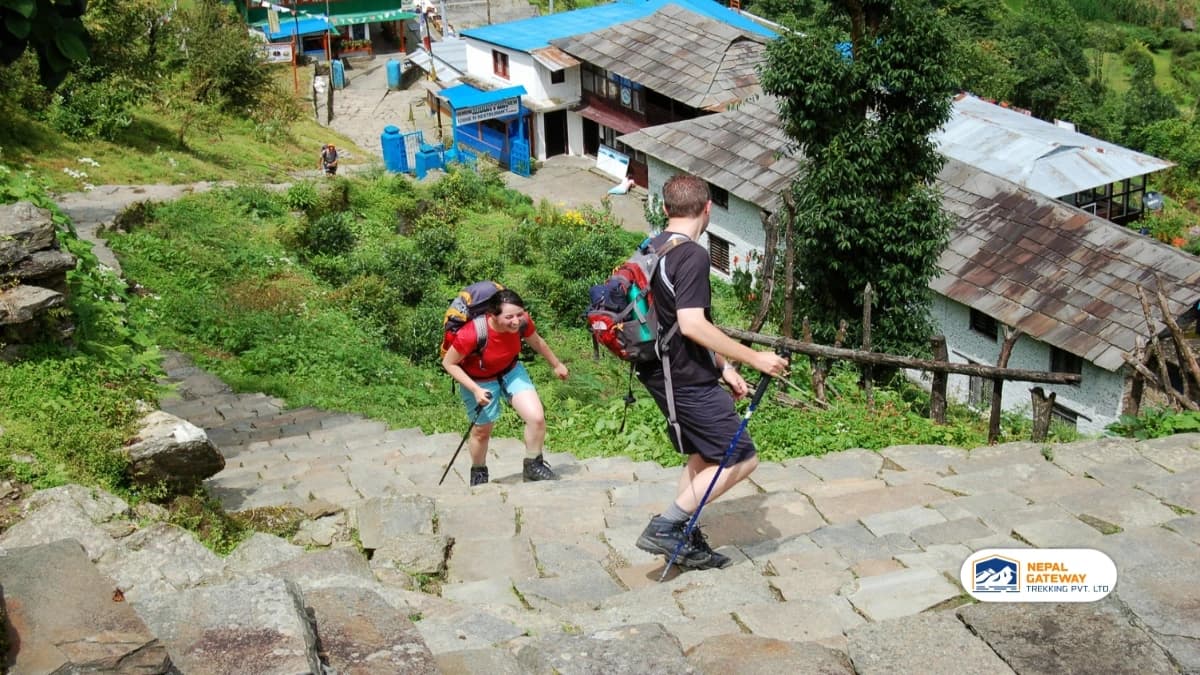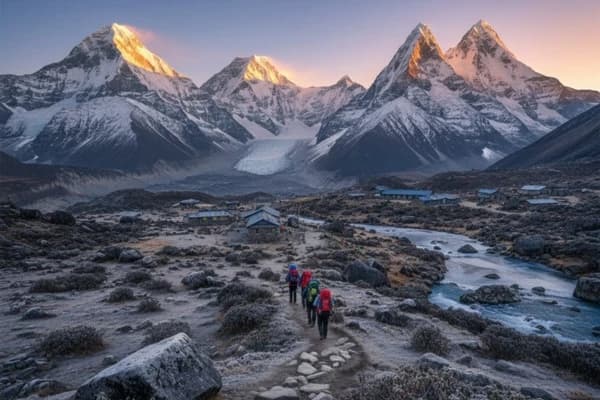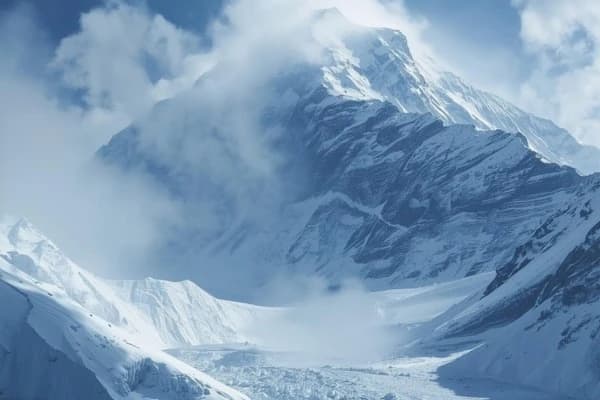So, you’ve got your hiking boots ready, your backpack packed (almost), and your heart set on the Annapurna Base Camp Trek—excellent choice!
But before you jump on a plane to Nepal, there’s one super important question: When is the best time to do the Annapurna Base Camp Trek?
Your trip could easily go south if you don't pick the ideal time to complete the Annapurna Base Camp Trek.
Although the Annapurna region is beautiful all year round, its moods and seasons can make your climb either a wonderful experience or, well, a little stressful.
Ensuring you receive that incredible photo, safe and comfortable trekking conditions, and the opportunity to experience Nepal's rich culture and hospitality along the way are more important than simply avoiding the rain or the cold.
Now here’s the good part: when you go at the right time, everything just clicks. The views? Unforgettable. The weather? Clear and comfy. The trails? Quiet, green, and sometimes bursting with flowers.
You’ll snap those once-in-a-lifetime photos, soak in the beauty of the Himalayas, and enjoy the warm culture and hospitality Nepal is famous for.
Whether you’re new to trekking or a total pro, knowing the best time to do the Annapurna Base Camp Trek makes all the difference.
Stick with us—we’ll walk you through the Annapurna Trek month-by-month breakdown, what to expect, and how to prep like a champ.
Ready to uncover the perfect window for your adventure? Let’s dive in and get you set up for an unforgettable trek to Annapurna Base Camp!
Why Timing Matters for your ABC Trek?
As someone who’s trekked these trails and guided others through them, I can tell you firsthand: timing makes or breaks the experience. You might think you're just planning around weather, but it’s so much more than that.
Choosing the right season means better visibility for those jaw-dropping mountain views, easier walking conditions, and a much better chance of avoiding altitude-related issues. Plus, the local teahouses—your cozy rest stops along the way—feel more welcoming and relaxed when you’re not trekking during peak crowd chaos.
Picking the best time to do the Annapurna Base Camp Trek isn’t just about comfort; it can totally shape how amazing your adventure will be. The weather, trail conditions, mountain views, and even the vibe of the teahouses all depend heavily on when you hit the trail.
You wouldn’t bring an umbrella to a desert, right? Same thing here.
Pick the right time, and you'll enjoy
- Clear skies and epic mountain views
- Comfortable walking weather
- Trails bursting with flowers or golden leaves
- Cozy teahouses with good food and friendly faces
Pick the wrong time, and you might face
- Slippery, muddy trails
- Cold nights that freeze your toes off
- Rainy days with no mountain views in sight
- Leeches (yes, really)
- Empty teahouses or closed lodges
The season you choose can make or break your trip.
Choosing the best time to do the Annapurna Base Camp Trek means more than hiking—it’s a magical experience with stunning views, peaceful trails, and warm local hospitality. Plan smart and make your trek unforgettable!
When you pick the right season for the Annapurna Base Camp Trek, you unlock amazing weather, clear views, and quiet trails. It’s not just a trek—it’s an unforgettable adventure. Plan well and enjoy every moment!
The best time to do the Annapurna Base Camp Trek is when you avoid crowds and bad weather, giving you clear skies and stunning scenery. Plan carefully and turn your trek into a truly unforgettable journey!
You might also be interested in knowing the best time for Annapurna Circuit Trek which is very similar to ABC Trek.
What Is the Best Season for the Annapurna Base Camp Trek?
The Annapurna Base Camp Trek is most enjoyable in the spring (March to May) and fall (September to November) seasons. Your walk will be safe and enjoyable during these seasons because of the bright skies, pleasant temperatures, and breathtaking Himalayan views.
Spring: Nature’s Colour Party
Spring is like the trail’s grand makeover every year. As the snow melts away, the entire Annapurna valley bursts into life with vibrant rhododendron flowers painting the hillsides in bright reds, soft pinks, and pure whites. It’s like walking through a living, breathing garden that stretches as far as the eye can see. The fresh mountain air warms up just enough during the day to feel comfortably cool, usually between 10°C and 20°C, making it perfect for hiking without feeling overheated or exhausted.
If you’re wondering when to experience this colourful magic, the Annapurna Base Camp Trek in spring is the ideal choice for nature lovers and photographers alike. Also know the best time for trekking in Nepal for better experience.
Heads-up: As you get closer to late May, the monsoon starts knocking on Nepal’s door. You might get caught in a few rain showers, but overall, spring is a top choice if you love colour and milder temps.
Autumn: Crystal Clear and Crowded for a Reason
Autumn is the golden season for trekking to Annapurna Base Camp. After the monsoon has washed everything clean, the skies open up to reveal the most stunning views of Annapurna I, Machapuchare (Fishtail), and other giants.
Temperatures are comfy (12°C to 18°C during the day), and the mountain air is crisp.
Caution: You’re sharing the trail with a lot more people. Teahouses get busy, but the vibes are festive, and you’ll find plenty of fellow trekkers to share stories with.
Annapurna Base Camp Trek Weather by Month

Planning your trek means knowing what kind of weather you’ll face each month — and trust me, it changes a lot up in the Annapurna region. Here’s a quick and friendly month-by-month guide to help you figure out when to lace up those boots:
January & February – Cold but Clear
- Very cold, especially at night
- Icy trails in places
- Quiet and peaceful
- Clear skies = great views
Tip: Layer up and bring your warmest socks!
March to May – Springtime Glory
- Warm days, cool nights
- Flowers bloom like crazy
- Amazing views
- One of the best times to go
Tip: Perfect for Instagram photos and comfy hikes!
June to August – Monsoon Mess
- Heavy rain, slippery trails
- Leeches are active
- Clouds block the mountains
- Flights may be delayed
But…
- Green, lush landscapes
- Very few people are on the trail
Verdict: Not ideal unless you love rain and adventure.
September to November – Trekker’s Paradise
- Clear skies and fresh air
- Comfortable temps
- Stunning views all around
- Great for both beginners and pros
Note: Book early—it’s peak season for a reason.
December – Cold and Quiet
- Cold again, but dry
- Fewer crowds
- Some teahouses may close
- Beautiful and peaceful
Tip: If you love quiet trails and don’t mind the cold, this one’s for you.
Are you excited to know what types of food and accommodation you will get in the trek? Read about the food and accommodation you will get in Annapurna Circuit Trek .
The Worst Time to Do the Annapurna Base Camp Trek?
Most trekkers agree—monsoon season (June to August) is the roughest time for the Annapurna Base Camp Trek. Trails get muddy, views disappear behind clouds, and leeches are everywhere. It’s wet, messy, and not ideal for first-timers.
Nevertheless, it's very serene, very green, and has breathtaking waterfalls. It might be your kind of experience if you enjoy isolation and don't mind the rain. Otherwise, for the greatest experience, wait till spring or fall.
Just keep in mind that the mountains have their own appeal, especially during the off-season. You might just love the untamed, unpolished side of the Himalayas if you're adaptable, prepared, and willing to get a little muddy.
But like any adventure, it has its ups and downs. Let’s break down the pros and cons so you know what you’re really getting into.
Cons
- Muddy Trails & Heavy Rain: The monsoon season brings almost continual rain. Hiking becomes perilous and exhausting when the trails turn muddy and slippery.
- Landslides & Path Closures: The heavy downpours often cause landslides that can block or wash away parts of the trail, leading to unexpected detours or cancellations.
- Obstructed Mountain Views: Thick clouds and fog are common during monsoon, hiding the stunning Annapurna peaks you trekked so far to see.
- Leeches: Wet trails attract leeches, which can be an unpleasant surprise for many trekkers.
- Flight Delays: Bad weather frequently causes flights to and from Pokhara, the starting point for the journey, to be delayed or cancelled, which can cause disruptions to your travel schedule.
- Limited Services: Some teahouses and lodges might reduce services or even close during the wettest months.
Pros
- Solitude & Peace: The monsoon season sees very few trekkers, so you get to enjoy the trail in near solitude—no crowds, just you and nature.
- Lush Greenery: The landscape transforms into a vibrant green paradise with blooming flora and flowing waterfalls, creating a unique and beautiful trekking environment.
- Cooler Temperatures: The rain cools things down, so you won’t have to battle the heat during your hike.
Verdict: Skip it unless you really love rain and solitude.
If you think, you can not handle the days long ABC Trek, you can also explore short Annapurna Base Camp Trek provided by Nepal Gateway Trekking.
Winter Trekking: Cold, Quiet, and Magical?
Yes, you can trek to Annapurna Base Camp in winter (December to February), but brace yourself. Nights drop below freezing, and some parts of the trail might be snow-covered. The lodges are quieter, which is excellent if you want peace, but some places close or offer limited meals.
Tip: Great if you want solitude and don’t mind bundling up!
What’s Your Perfect Trekking Time? Match It to Your Style!

Alright, here’s the deal: the best time to do the Annapurna Base Camp Trek really depends on what kind of trekker you are. Different seasons bring different vibes, so let’s figure out which one matches your style perfectly.
- Love killer mountain views and perfect weather?
Then autumn (September to November) and spring (March to May) are your best bets. These seasons serve up crystal-clear skies, dry trails, and comfortable temperatures — basically, the dream combo for snapping those postcard-perfect photos and enjoying smooth trekking days. - Are you a flower lover?
Spring is absolutely magical. The trails burst into colour with blooming rhododendrons and wildflowers everywhere. Daytime temps hover nicely between 10°C and 20°C — not too hot, not too cold — making it super comfortable for hiking. Plus, the fresh, flowery air just makes everything feel alive. - Want fewer people around and don’t mind the cold?
Winter (December to February) could be your calling. It’s chilly — think freezing nights and snow in higher spots — but the trails are peaceful, and the skies are often clear and bright. It’s perfect if you want to dodge the crowds and enjoy some profound solitude. - Craving a quiet trek with lush greenery and can brave some rain?
Then the monsoon (June to August) might actually be your style. The trails are wet and slippery, sure, and leeches are a pain, but you’ll have the whole place almost to yourself. The valley turns into a vibrant, green paradise — just pack your rain gear and a strong spirit. - Budget-conscious?
Off-seasons like monsoon and winter usually mean cheaper prices for lodges and guides. Just keep in mind that services might be limited, and the weather might be more challenging.
Here’s a quick match-making guide to help you pick your time:
|
If you love... |
Go in... |
|
Flowers, colours, comfy hikes |
Spring (Mar–May) |
|
Clear skies, perfect views, big crowds |
Autumn (Sep–Nov) |
|
Quiet paths, chilly nights, clear days |
Winter (Dec–Feb) |
|
Lush greenery, rain, total peace |
Monsoon (Jun–Aug) |
For safe and better Trekking, visit Nepal Tourism Board and know all about the tourism in Nepal.
Why Does Choosing the Right Time for the Annapurna Base Camp Trek Matter So Much?
The best time to do the Annapurna Base Camp Trek really depends on what kind of adventure you want. Spring and autumn are safe bets, especially if you want good weather and clear views. But if you're after peace and don’t mind a challenge, winter or even monsoon might surprise you.
Just remember this old saying:
“Better to bend with the season than break from the storm.”
Remember, the Annapurna region is stunning year-round, but picking the right season means you’ll enjoy every step without unnecessary struggles.
Ready to plan your ABC Trek at the perfect time? Let Nepal Gateway Trekking guide you safely and confidently on your unforgettable journey. Your perfect trek is just around the corner!
Choose Nepal Gateway Trekking for Your Annapurna Base Camp Trek
Planning a trek to Annapurna Base Camp can be exciting but also a bit stressful. That’s why Nepal Gateway Trekking is here to make it easy for you. Whether you’re a beginner or an experienced trekker, they specialize in helping you choose the best time to do the Annapurna Base Camp Trek to get the most out of your journey.
With expert local guides who know every trail and hidden gem, customized itineraries tailored to your pace, and full support throughout your adventure, Nepal Gateway Trekking ensures your trip is safe, comfortable, and unforgettable. They also handle permits, accommodation bookings, and even offer tips on packing and acclimatization.
Don’t risk your dream trek to guesswork — let the pros help you plan smart and trek with confidence. Contact Nepal Gateway Trekking today and start your Himalayan adventure on the right foot!
Traveller’s Questions
What is the best month to do the Annapurna Base Camp Trek?
October and November are considered the best months to do the Annapurna Base Camp Trek. During this time, you’ll experience the clearest skies, stunning mountain views, and comfortable temperatures, making it ideal for photography and trekking comfort.
Can I trek in spring?
Absolutely! The Annapurna Base Camp Trek in spring is fantastic, with blooming rhododendron flowers adding vibrant colours along the trail. The weather is pleasant, with mild temperatures and mostly clear skies, perfect for those who love nature’s beauty.
Is trekking during the monsoon a good idea?
Generally, trekking during the monsoon (June to August) is not recommended due to heavy rain, slippery trails, and the risk of landslides. However, adventurous trekkers who don’t mind wet conditions and fewer crowds sometimes choose this season.
How cold does it get in winter?
Winter nights, especially at higher altitudes, can drop below -10°C, making it quite cold. Daytime temperatures are chilly but manageable with proper clothing. Trekkers should be well-prepared with warm gear if trekking in winter.
Do I need a guide?
Although not required, hiring a guide is strongly advised. Your entire trekking experience is improved by guides, who offer crucial safety assistance, local knowledge, cultural insights, and assistance navigating challenging sections of the trail.
Are teahouses open year-round?
Most teahouses along the Annapurna Base Camp Trek remain open throughout the year. However, during the off-season winter months, some may have limited services or close temporarily, so it’s good to plan accordingly.
What permits do I need?
You need two main permits for the Annapurna Base Camp Trek: the Trekker’s Information Management System (TIMS) card and the Annapurna Conservation Area Permit (ACAP). These help regulate trekking and support conservation efforts.
How crowded does it get in autumn?
Autumn is the busiest trekking season, so you should expect crowded trails, full lodges, and bustling teahouses. Booking accommodations early is advised to secure your spots during this peak period.
Can I trek solo?
Yes, solo trekking is possible on this route, but hiring a guide or joining a group is safer and can make the trek more enjoyable, especially if you’re new to high-altitude trekking.
What gear should I pack?
Pack layered clothing for changing weather, a reliable rain jacket, warm hat and gloves for cold nights, sturdy hiking boots, and plenty of sunscreen. Don’t forget trekking poles and a good daypack for essentials.





